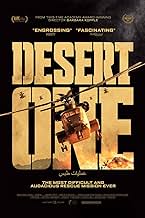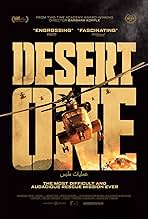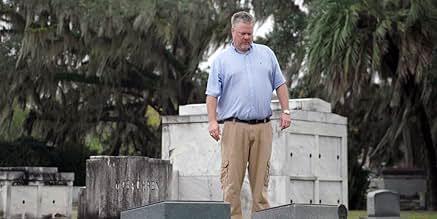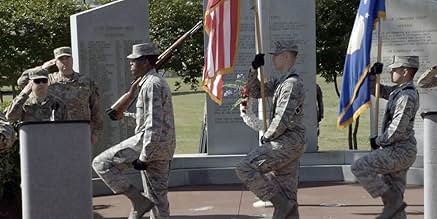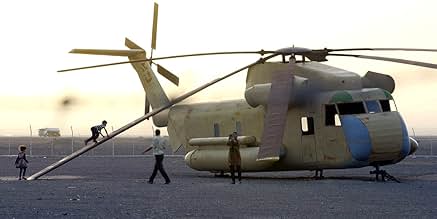Using new archival sources and unprecedented access, master documentarian Barbara Kopple reveals the story behind one of the most daring rescues in modern US history: a secret mission to fre... Read allUsing new archival sources and unprecedented access, master documentarian Barbara Kopple reveals the story behind one of the most daring rescues in modern US history: a secret mission to free hostages of the 1979 Iranian revolution.Using new archival sources and unprecedented access, master documentarian Barbara Kopple reveals the story behind one of the most daring rescues in modern US history: a secret mission to free hostages of the 1979 Iranian revolution.
- Awards
- 1 nomination total
James Q. Roberts
- Self - U.S. Army
- (as Maj James O. Roberts)
John Pustay
- Self - Deputy to Chairman, Joint Chiefs of Staff
- (as LTG John Putsay)
Kenneth Bancroft
- Self - U.S. Air Force
- (as TSgt Kenneth Bancroft)
Lewis Burruss
- Self - Delta Force
- (as Maj Lewis "Bucky" Burruss)
William G. Boykin
- Self - Delta Force
- (as Maj William G. Boykin)
Bucky Buchanan
- Self - U.S. Marine Corps
- (as SSgt Bucky Buchanan)
John Sigman
- Self - U.S. Marine Corps
- (as GySgt John Sigman)
Ed Seiffert
- Self - U.S. Marine Corps
- (as Col Ed Seiffert)
- Director
- Writer
- All cast & crew
- Production, box office & more at IMDbPro
Featured reviews
Desert One covers the 1980 hostage situation between Iran and United States. Desert one does a good job at showing both perspectives of the situation from start to finish, as in before the 52 Americans were taken hostage to the release of the hostages. The film presents the main elements of the situation through, old television news footage of both Iran and American perspectives, many people who were involved in the situation for example; Jimmy Carter (president of the United States at the time), multiple hostages, men who was part of the rescue mission, Iranian civilians indirectly involved in the situation and Iranian guards of the hostages. This film chose to animate what happened at the rescue mission and they did a great job, the story telling over the animation gave the recreation of the event such a vivid feeling, it really made it feel like they filmed the actual rescue mission. Interviews of the people involved in the situation were well done and helped to make the story that much better. Good film.
This is a documentary about the 1980 Iran hostage crisis. I expected this to be more a detailed examination of the preparations and then the execution of the hostage rescue. I know the rescue was short-circuited by the accident. So I expected a lot of preparations to fill this up. Instead, there is next to no preparations. I don't mean the documentary doesn't have much on the preparations. I mean the operation doesn't seem to have much preparations. There is one snippet of a participant complaining about President Carter delaying the operation. My feeling is that he should be happy about the delay so that they could do as many run-throughs as possible. I expected a replica of the embassy. I expected a full replica of the neighborhood. I expected some planning for the refueling area. I am confused about the lack of practice before the big game. This documentary is a regurgitation of everything around the event. A lot of this is well known. I wasn't around back then so some of the minutia is new to me. I didn't know a mother went to visit one of the hostages. The recreation of the rescue is done with comic style drawings. It's probably the most compelling part of the movie and worthwhile to be remade into an action thriller. Of course, Hollywood likes a happy ending which isn't this. This is probably never getting the full theatrical treatment.
Desert One provides a thoughtful revisit to one of the greatest intelligence failures in recent American history. How is it possible that this tragic mission was green-lighted at the highest levels of our government when according to the film, its realistic chances for success seemed so painfully and obviously lacking? As the documentary clearly points out, a key element in the rescue plan required a nighttime multi-helicopter journey over hundreds of miles of unknown (and likely dangerous) desert terrain and weather conditions. Apparently all of this was to be done with only limited advance preparation and thus a minimal awareness of the probable circumstances we could reasonably expect to encounter in the mission.
It is said that success has many parents but failure is always an orphan. Desert One presents an obvious example of just how true this statement is. As the documentary recalls one unforeseen and surprising event after another---the cumulative effects of which ultimately led to an aborting of the mission--we again are struck by its apparent lack of appropriate readiness and the absence of reliable intelligence that denied us the opportunity to get a more sober assessment of Operation Eagle Claw's chances for a positive outcome.
Desert One unfolds in a sober and riveting way as it tells us the story of this mission, the truly brave men who participated in it and where and how it went wrong. Of course unanswered questions remain. Who were the principal cabinet advisors who counseled President Carter to go ahead with Operation Eagle Claw given all its risks? Why were we so ill prepared to deal with the real conditions encountered on the ground? Could the mission have been aborted sooner based upon the facts experienced at the time?
We come away from seeing Desert One much better informed about this sad episode. That is the hallmark of a good documentary. We should be grateful to all who participated in its creation who enabled us to better understand the facts depicted in Desert One. And when another such dangerous mission does turn out well--like the later taking out of Osama Bin Laden-we should better appreciate the tremendous difficulties heroic Americans needed to overcome to achieve that success.
It is said that success has many parents but failure is always an orphan. Desert One presents an obvious example of just how true this statement is. As the documentary recalls one unforeseen and surprising event after another---the cumulative effects of which ultimately led to an aborting of the mission--we again are struck by its apparent lack of appropriate readiness and the absence of reliable intelligence that denied us the opportunity to get a more sober assessment of Operation Eagle Claw's chances for a positive outcome.
Desert One unfolds in a sober and riveting way as it tells us the story of this mission, the truly brave men who participated in it and where and how it went wrong. Of course unanswered questions remain. Who were the principal cabinet advisors who counseled President Carter to go ahead with Operation Eagle Claw given all its risks? Why were we so ill prepared to deal with the real conditions encountered on the ground? Could the mission have been aborted sooner based upon the facts experienced at the time?
We come away from seeing Desert One much better informed about this sad episode. That is the hallmark of a good documentary. We should be grateful to all who participated in its creation who enabled us to better understand the facts depicted in Desert One. And when another such dangerous mission does turn out well--like the later taking out of Osama Bin Laden-we should better appreciate the tremendous difficulties heroic Americans needed to overcome to achieve that success.
This doc fails to mention that Reagan/Bush had the hostages held an extra 100 days in exchange for tow missles which led to Iran Contra. The irony is that Carter was there to meet the hostages being released while Reagan the Traitor was being inaugurated.
Sad to whitewash history when you have the chance to tell the truth.
From Esquire : What happened next Mr. Barnes has largely kept secret for nearly 43 years. Mr. Connally, he said, took him to one Middle Eastern capital after another that summer, meeting with a host of regional leaders to deliver a blunt message to be passed to Iran: Don't release the hostages before the election. Mr. Reagan will win and give you a better deal. Then shortly after returning home, Mr. Barnes said, Mr. Connally reported to William J. Casey, the chairman of Mr. Reagan's campaign and later director of the Central Intelligence Agency, briefing him about the trip in an airport lounge.
Mr. Barnes identified four living people he said he had confided in over the years: Mark K. Updegrove, president of the L. B. J. Foundation; Tom Johnson, a former aide to Lyndon Johnson (no relation) who later became publisher of the Los Angeles Times and president of CNN; Larry Temple, a former aide to Mr. Connally and Lyndon Johnson; and H. W. Brands, a University of Texas historian. All four of them confirmed in recent days that Mr. Barnes shared the story with them years ago. "As far as I know, Ben never has lied to me," Tom Johnson said, a sentiment the others echoed. Mr. Brands included three paragraphs about Mr. Barnes's recollections in a 2015 biography of Mr. Reagan, but the account generated little public notice at the time.
Sad to whitewash history when you have the chance to tell the truth.
From Esquire : What happened next Mr. Barnes has largely kept secret for nearly 43 years. Mr. Connally, he said, took him to one Middle Eastern capital after another that summer, meeting with a host of regional leaders to deliver a blunt message to be passed to Iran: Don't release the hostages before the election. Mr. Reagan will win and give you a better deal. Then shortly after returning home, Mr. Barnes said, Mr. Connally reported to William J. Casey, the chairman of Mr. Reagan's campaign and later director of the Central Intelligence Agency, briefing him about the trip in an airport lounge.
Mr. Barnes identified four living people he said he had confided in over the years: Mark K. Updegrove, president of the L. B. J. Foundation; Tom Johnson, a former aide to Lyndon Johnson (no relation) who later became publisher of the Los Angeles Times and president of CNN; Larry Temple, a former aide to Mr. Connally and Lyndon Johnson; and H. W. Brands, a University of Texas historian. All four of them confirmed in recent days that Mr. Barnes shared the story with them years ago. "As far as I know, Ben never has lied to me," Tom Johnson said, a sentiment the others echoed. Mr. Brands included three paragraphs about Mr. Barnes's recollections in a 2015 biography of Mr. Reagan, but the account generated little public notice at the time.
"Desert One" (2020 release; 107 min.) is a documentary that examines what exactly happened with the doomed 1980 secret mission to rescue the 52 US hostages being held in Tehran. As the movie opens, we are "April 24, 1980" as choppers are getting ready to depart from the USS Nimitz. We then go back in time and we get an "Iran 101" crash course on what has happening in the 1960s and 70s, as it all leads up to the Iranian revolution in 1979 and the subsequent storming of the US Embassy. At this point we are 10 min. into the documentary.
Couple of comments: this is the latest documentary from double Oscar-winning documentarian Barbara Kopple. My regard for her is such that I will watch any documentary she makes, no questions asked. Heck, if she were to make a documentary about the erstwhile Yellow Pages, I'd go see that! But here she examines what transpired exactly 40 year ago this summer, when President Carter send in a Special Ops Delta Force, and I mean the best of the best. As to the rescue mission, with 20/20 hindsight it was clear that chances for a good outcome were low. That is acknowledged by many who participated in the mission, speaking here on camera. It also is astonishing how ill equipped the helicopters were for this mission (2 of the 8--25%!! think about that--malfunctioned). As to the mission participants themselves, they are true heroes in every which way. Sadly 8 of them lost their lives. When the mission returns to base (outside of Iran), and British solders piece together what has been happening, they sent over some cases of beer with the note "To you all from us having the guts to try". Lastly, as to the documentary itself, it unearths tons of footage and audio tapes that I had never seen or heard before. Today's (fragile looking) Carter, Mondale and many other key people from that era, including of course several who were held hostage, and several who participated in the rescue mission, are all given plenty of screen time. I found this to be a very insightful documentary on many levels.
"Desert One" opened this past weekend at my local art-house theater here in Cincinnati, while requiring strict adherence to all COVID-19 rules. Not that it mattered, as the Tuesday early evening screening where I saw this at turned out to be a private screening. I was literally the only person in the theater. If you love a good documentary or have an interest in finding out more about the ill-fated Iran rescue mission, I'd readily suggest you check this out, be it in the theater, on VOD, or eventually on DVD/Blu-ray, and draw your own conclusion.
Couple of comments: this is the latest documentary from double Oscar-winning documentarian Barbara Kopple. My regard for her is such that I will watch any documentary she makes, no questions asked. Heck, if she were to make a documentary about the erstwhile Yellow Pages, I'd go see that! But here she examines what transpired exactly 40 year ago this summer, when President Carter send in a Special Ops Delta Force, and I mean the best of the best. As to the rescue mission, with 20/20 hindsight it was clear that chances for a good outcome were low. That is acknowledged by many who participated in the mission, speaking here on camera. It also is astonishing how ill equipped the helicopters were for this mission (2 of the 8--25%!! think about that--malfunctioned). As to the mission participants themselves, they are true heroes in every which way. Sadly 8 of them lost their lives. When the mission returns to base (outside of Iran), and British solders piece together what has been happening, they sent over some cases of beer with the note "To you all from us having the guts to try". Lastly, as to the documentary itself, it unearths tons of footage and audio tapes that I had never seen or heard before. Today's (fragile looking) Carter, Mondale and many other key people from that era, including of course several who were held hostage, and several who participated in the rescue mission, are all given plenty of screen time. I found this to be a very insightful documentary on many levels.
"Desert One" opened this past weekend at my local art-house theater here in Cincinnati, while requiring strict adherence to all COVID-19 rules. Not that it mattered, as the Tuesday early evening screening where I saw this at turned out to be a private screening. I was literally the only person in the theater. If you love a good documentary or have an interest in finding out more about the ill-fated Iran rescue mission, I'd readily suggest you check this out, be it in the theater, on VOD, or eventually on DVD/Blu-ray, and draw your own conclusion.
Did you know
- GoofsThe occupants of the C130 are looking out of the left-hand paratroop door at the fire; someone closes the door but it slides left to right. The paratroop door opens vertically, so it should slide down to close.
- Quotes
Jimmy Carter: Do you have any report on the helicopter's location?
- ConnectionsReferences ABC News Nightline (1979)
Details
- Release date
- Country of origin
- Official site
- Languages
- Also known as
- Desert One - Gidseldramaet i Teheran
- Filming locations
- Production companies
- See more company credits at IMDbPro
Box office
- Budget
- $1,500,000 (estimated)
- Runtime
- 1h 48m(108 min)
- Color
Contribute to this page
Suggest an edit or add missing content




